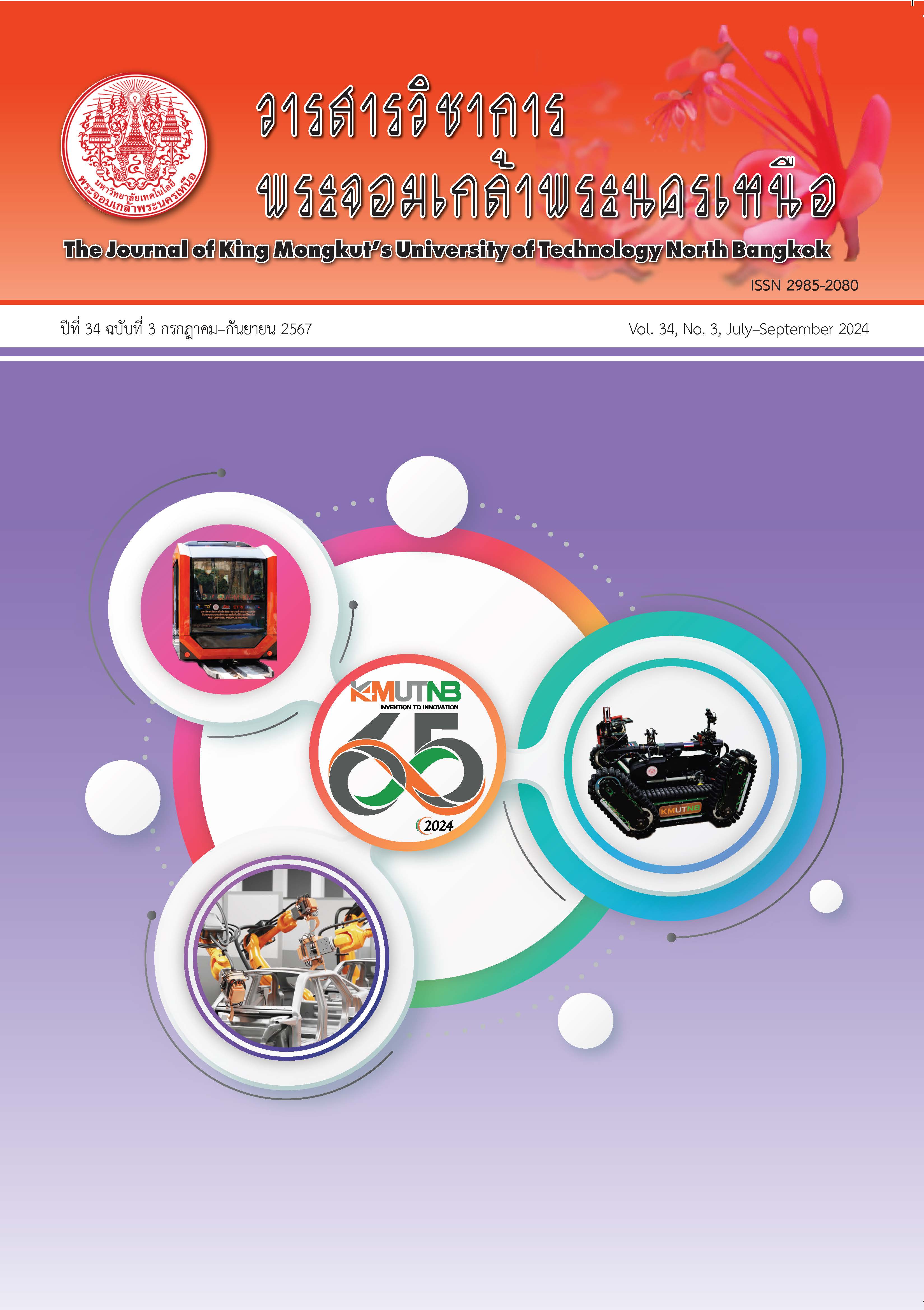อิทธิพลของระยะเวลาการดูดซับน้ำต่ออัตราส่วนผสมที่เหมาะสมของวัสดุเชิงประกอบพลาสติกและไม้โดยใช้การออกแบบการทดลองแบบผสมและวิธีพื้นผิวตอบสนอง
Main Article Content
บทคัดย่อ
งานวิจัยฉบับนี้มีวัตถุประสงค์เพื่อทำนายอัตราส่วนผสมที่เหมาะสมของวัสดุเชิงประกอบพลาสติกและไม้ (Wood-Plastic Composites; WPCs) เพื่อใช้ในการออกแบบผลิตภัณฑ์ที่มีการใช้งานที่สัมผัสความชื้นสูง โดยทำการออกแบบการทดลองแบบผสม (Mixture Design) ซึ่งมีปัจจัย คือ พอลิโพรพีลีนรีไซเคิล ขี้เลื่อยไม้ยางพารา คาร์บอนแบล็ค สารควบคู่ และสารหล่อลื่น ตามลำดับ ทำการวิเคราะห์ผลการทดลองด้วยการวิเคราะห์ความแปรปรวน (ANOVA) และทำนายอัตราส่วนผสมที่เหมาะสมด้วยวิธีพื้นผิวการตอบสนอง (Response Surface Methodology; RSM) ผลจากการทดลองพบว่า ระยะเวลาการดูดซับน้ำมีผลอย่างมีนัยสำคัญ (P < 0.05) ต่อสมบัติความแข็งและเปอร์เซ็นต์การดูดซับน้ำ การเพิ่มขึ้นของสารเสริมแรง คือ ขี้เลื่อยไม้ยางพาราและคาร์บอนแบล็คส่งผลให้สมบัติความแข็งเพิ่มขึ้น นอกจากนี้ สมการถดถอย (Regression Model) และกราฟโครงร่าง (Contour Plot) แสดงถึงอิทธิพลของปัจจัยและผลการทำนายอัตราส่วนผสมที่เหมาะสมของแต่ละสมบัติ โดยอัตราส่วนผสมที่เหมาะสมร่วมกันของทุกสมบัติ คือ 55.6wt% rPP, 29.5wt% RWS, 10.0wt% CB, 3.9wt% MAPP, และ 1.0wt% WAX ด้วยค่าความพึงพอใจจากการทำนาย คือ 84.70% ตามลำดับ และเพื่อความถูกต้องและแม่นยำของการทำนายผลการตอบสนอง อัตราส่วนผสมที่เหมาะสมจากการทำนายถูกขึ้นรูปและทำการทดลองจริง (Observed) เพื่อหาเปอร์เซ็นความแตกต่างและค่าเบี่ยงเบนมาตรฐานของการทดลอง
Article Details

อนุญาตภายใต้เงื่อนไข Creative Commons Attribution-NonCommercial-NoDerivatives 4.0 International License.
บทความที่ลงตีพิมพ์เป็นข้อคิดเห็นของผู้เขียนเท่านั้น
ผู้เขียนจะต้องเป็นผู้รับผิดชอบต่อผลทางกฎหมายใดๆ ที่อาจเกิดขึ้นจากบทความนั้น
เอกสารอ้างอิง
C. Srivabut, T. Ratanawilai, and S. Hiziroglie, “Effect of nanoclay, talcum, and calcium carbonate as filler on properties of composites manufactured from recycled polypropylene and rubberwood fiber,” Construction and Building Materials, no. 162, pp. 450–458, 2018.
C. Homkhiew, W. Boonchouytan, S. Rawangwong, and T. Ratanawilai “Optimal manufacturing parameters of rubberwood flour/high density polyethylene composites using Box–Behnken design,” The Journal of KMUTNB, vol. 27, no. 2, pp. 315–328, 2017 (in Thai).
N. Ayrilmis, U. Buyuksari, and T. Dundar, “Waste pine cones as a source of reinforcing fillers for thermoplastic composites,” Journal of Applied Polymer Science, vol. 117, no. 4, pp. 2324–2330, 2010.
R. Z. Huang, B. J. Kim, S. Lee, Z. Yang, and Q. L. Wu, “Co-extruded wood-plastic composites with talc-filled shells: morphology, mechanical, and thermal expansion performance,” BioResources, vol. 8, no. 2, pp. 2283-2299, 2013.
R. Z. Huang, C. T. Mei, X. W. Xu, T. Karki, S. Lee, and Q. L. Wu, “Effect of hybrid talcbasalt fillers in the shell layer on thermal and mechanical performance of co-extruded wood plastic composites,” Materials, vol. 8, no. 2, pp. 8510–8523, 2015.
S. Khamtree, T. Ratanawilai, and S. Ratanawilai, “The effect of alkaline-silane treatment of rubberwood flour for water absorption and mechanical properties of plastic composites,” Journal of Thermoplastic Composites Material, vol. 33, no. 5, pp. 599–613, 2020.
C. Homkhiew, T. Ratanawilai, and W. Thongruang, “The optimal formulation of recycled polypropylene/rubberwood flour composites from experiments with mixture design,” Composites Part B: Engineering, vol. 56, pp. 350–357, 2014.
N. Jarunjaruphat and S. Acharry, “The particleboard manufacturing from agricultural waste,” The Journal of KMUTNB, vol. 28, no. 2, pp. 469–476, 2018 (in Thai).
T. Ratanawilai and K. Taneerat, “Alternative polymeric matrices for wood-plastic composites: Effects on mechanical properties and resistance to natural weathering,” Construction and Building Materials, vol. 172, pp. 349–357, 2018.
C. Homkhiew and T. Ratanawilai, “Optimal proportions of composites from polypropylene and rubberwood flour after water immersion using experimental design,” KKU Research Journal, vol. 19, pp. 780–793, 2014 (in Thai).
C. Srivabut, T. Ratanawilai, S. Hiziroglie, “Response surface optimization and statistical analysis of composites made from calcium carbonate filler-added recycled polypropylene and rubberwood fiber,” Journal of Thermoplastic Composites Material, 2019.
L. Soccalingame, A. Bourmaud, D. Perrin, J. C. Benezet, and A. Bergeret, “Reprocessing of wood flour reinforced polypropylene composites: Impact of particle size and coupling agent on composite and particle properties,” Polymer Degradation Stability, vol. 13, pp. 72–85, 2015.
H. Essabir, R. Boujmal, M. O. Bensalah, D. Rodrigue, R. Bouhfid, and A. E. Qaiss, “Mechanical and thermal properties of hybrid composites: Oil-palm fiber/clay reinforced high density polyethylene,” Mechanics of Materials, vol. 98, pp. 36–43, 2016.
B. Kord, A. Varshoei, and V. Chamany, “Influence of chemical foaming agent on the physical, mechanical, and morphological properties of HDPE/wood flour/nanoclay composites,” Journal of Reinforced Plastics and Composites, vol. 30, no. 13, pp. 1115–1124, 2011.
C. Srivabut, T. Ratanawilai, and S. Hiziroglie, “Statistical modeling and response surface optimization on natural weathering of woodplastic composites with calcium carbonate filler,” Journal of Material Cycles and Waste Management, vol. 23, pp. 1503–1517, 2021.
C. Homkhiew, S. Rawangwong, W. Boonchouytan, “Optimizing Condition for manufacturing the binderless particleboard by response surface methodology,” The Journal of Industrial Technology, vol. 11, no. 2, pp. 40–55, 2015 (in Thai).

